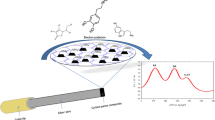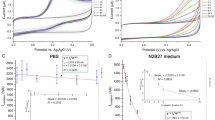Abstract
Glutamate is the main excitatory neurotransmitter in the brain and plays a leading role in degenerative diseases, such as motor neuron diseases. Riluzole is a glutamate regulator and a therapeutic drug for motor neuron diseases. In this work, the interaction between glutamate and riluzole was studied using cyclic voltammetry and square-wave voltammetry at a glassy carbon electrode (GCE). It was shown that glutamate underwent a two-electron transfer reaction on the GCE surface, and the electrochemical detection limits of glutamate and riluzole were 483 μmol/L and 11.47 μmol/L, respectively. The results confirm that riluzole can promote the redox reaction of glutamate. This work highlights the significance of electrochemical technology in the sensing detection of the interaction between glutamate and related psychotropic drugs.








Similar content being viewed by others
References
Pál B. Involvement of extrasynaptic glutamate in physiological and pathophysiological changes of neuronal excitability. Cell Mol Life Sci. 2018;75(16):2917–49.
Yang SJ, Kim EA, Chang MJ, et al. N-Adamantyl-4-Methylthiazol-2-amine attenuates glutamate-induced oxidative stress and inflammation in the brain. Neurotox Res. 2017;32(1):107–20.
Hawkins RA. The blood-brain barrier and glutamate. Am J Clin Nutr. 2009;90(3):867S-874S.
Broeders TA, Bhogal AA, Morsinkhof LM, et al. Glutamate levels across deep brain structures in patients with a psychotic disorder and its relation to cognitive functioning. J Psychopharmacol. 2022;36(4):489–97.
Hynd MR, Scott HL, Dodd PR. Glutamate-mediated excitotoxicity and neurodegeneration in Alzheimer’s disease. Neurochem Int. 2004;45(5):583–95.
Niaz K, Zaplatic E, Spoor J. Extensive use of monosodium glutamate: A threat to public health?. EXCLI J. 2018;17:273–278. Published 2018 Mar 19.
Clarke G, O’Mahony S, Malone G, Dinan TG. An isocratic high performance liquid chromatography method for the determination of GABA and glutamate in discrete regions of the rodent brain [published correction appears in J Neurosci Methods. 2007 Sep 30;165(2):320]. J Neurosci Methods. 2007;160(2):223–230.
Doong RA, Shih HM. Array-based titanium dioxide biosensors for ratiometric determination of glucose, glutamate and urea. Biosens Bioelectron. 2010;25(6):1439–46.
Andersen JV, Markussen KH, Jakobsen E, et al. Glutamate metabolism and recycling at the excitatory synapse in health and neurodegeneration. Neuropharmacology. 2021;196:108719.
Castillo J, Dávalos A, Naveiro J, Noya M. Neuroexcitatory amino acids and their relation to infarct size and neurological deficit in ischemic stroke. Stroke. 1996;27(6):1060–5.
Zauner A, Bullock R, Kuta AJ, Woodward J, Young HF. Glutamate release and cerebral blood flow after severe human head injury. Acta Neurochir Suppl. 1996;67:40–4.
Andreadou E, Kapaki E, Kokotis P, et al. Plasma glutamate and glycine levels in patients with amyotrophic lateral sclerosis. In Vivo. 2008;22(1):137–41.
Stragierowicz J, Daragó A, Brzeźnicki S, Kilanowicz A. Optimization of ultra-performance liquid chromatography (UPLC) with fluorescence detector (FLD) method for the quantitative determination of selected neurotransmitters in rat brain. Optimization of ultra-performance liquid chromatography (UPLC) with fluorescence detector (FLD) method for the quantitative determination of selected neurotransmitters in rat brain. Med Pr. 2017;68(5):583–91.
Campos CDM, Reyes FGR, Manz A, da Silva JAF. On-line electroextraction in capillary electrophoresis: Application on the determination of glutamic acid in soy sauces. Electrophoresis. 2019;40(2):322–9.
Kim S, Okazaki S, Otsuka I, et al. Searching for biomarkers in schizophrenia and psychosis: Case-control study using capillary electrophoresis and liquid chromatography time-of-flight mass spectrometry and systematic review for biofluid metabolites. Neuropsychopharmacol Rep. 2022;42(1):42–51.
Lorenzo MP, Valiente L, Buendia I, Gortázar AR, Garcia A. Optimization and validation of a chiral CE-LIF method for quantitation of aspartate, glutamate and serine in murine osteocytic and osteoblastic cells. J Chromatogr B Analyt Technol Biomed Life Sci. 2020;1152:122259.
Moroz LL, Sohn D, Romanova DY, Kohn AB. Microchemical identification of enantiomers in early-branching animals: Lineage-specific diversification in the usage of D-glutamate and D-aspartate. Biochem Biophys Res Commun. 2020;527(4):947–52.
Ta HY, Collin F, Perquis L, Poinsot V, Ong-Meang V, Couderc F. Twenty years of amino acid determination using capillary electrophoresis: A review. Anal Chim Acta. 2021;1174:338233.
Qu WJ, Liu T, Chai Y, et al. Efficient detection of L-aspartic acid and L-glutamic acid by self-assembled fluorescent microparticles with AIE and FRET activities. Org Biomol Chem. 2023;21(19):4022–4027. Published 2023 May 17.
Xu Z, Ruisong W, Ligong C. Glucosamine modified near-infrared cyanine as a sensitive colorimetric fluorescent chemosensor for aspartic and glutamic acid and its applications. New J Chem. 2014;38(10):4791–8.
Ohkuma M, Kaneda M, Yoshida S, Fukuda A, Miyachi E. Optical measurement of glutamate in slice preparations of the mouse retina. Neurosci Res. 2018;137:23–9.
Amouzadeh Tabrizi M. A facile method for the fabrication of the microneedle electrode and its application in the enzymatic determination of glutamate. Biosensors (Basel). 2023;13(8):828. Published 2023 Aug 18.
Bermingham KP, Doran MM, Bolger FB, Lowry JP. Design optimisation and characterisation of an amperometric glutamate oxidase-based composite biosensor for neurotransmitter l-glutamic acid. Anal Chim Acta. 2022;1224:340205.
Maity D, Kumar RTR. Highly sensitive amperometric detection of glutamate by glutamic oxidase immobilized Pt nanoparticle decorated multiwalled carbon nanotubes(MWCNTs)/polypyrrole composite. Biosens Bioelectron. 2019;130:307–14.
Özel RE, Ispas C, Ganesana M, Leiter JC, Andreescu S. Glutamate oxidase biosensor based on mixed ceria and titania nanoparticles for the detection of glutamate in hypoxic environments. Biosens Bioelectron. 2014;52:397–402.
Liang B, Zhang S, Lang Q, Song J, Han L, Liu A. Amperometric L-glutamate biosensor based on bacterial cell-surface displayed glutamate dehydrogenase. Anal Chim Acta. 2015;884:83–9.
Gomes SP, Doležalová J, Araújo AN, et al. Glutamate sol-gel amperometric biosensor based on co-immobilised NADP+ and glutamate dehydrogenase. J Anal Chem. 2013;68:794–800.
Martínez-Periñán E, Domínguez-Saldaña A, Villa-Manso AM, Gutiérrez-Sánchez C, Revenga-Parra M, Mateo-Martí E, Pariente F, Lorenzo E. Azure A embedded in carbon dots as NADH electrocatalyst: development of a glutamate electrochemical biosensor. Sensors Actuators B: Chem. 2023;374:132761.
Zhenqing D, Junli G, Tiantian S, Jinfeng W, Zhida G, Yanyan S. Nature-inspired mineralization of a wood membrane as a sensitive electrochemical sensing device for in situ recognition of chiral molecules. Green Chem. 2021;23:8685–93.
Hughes G, Pemberton RM, Fielden PR, Hart JP. Trends Anal Chem. 2016;79:106–13.
Jörissen L. Bifunctional oxygen/air electrodes. J Power Sources. 2006;155(1):23–32.
Abdel-Aziz AM, Hassan HH, Badr IHA. Activated glassy carbon electrode as an electrochemical sensing platform for the determination of 4-nitrophenol and dopamine in real samples. ACS Omega. 2022;7(38):34127–35.
Zarate CA, Manji HK. Riluzole in psychiatry: a systematic review of the literature. Expert Opin Drug Metab Toxicol. 2008;4(9):1223–34.
Groeneveld GJ, van Kan HJ, Lie-A-Huen L, Guchelaar HJ, van den Berg LH. An association study of riluzole serum concentration and survival and disease progression in patients with ALS. Clin Pharmacol Ther. 2008;83(5):718–22.
Zarate CA Jr, Quiroz JA, Singh JB, et al. An open-label trial of the glutamate-modulating agent riluzole in combination with lithium for the treatment of bipolar depression. Biol Psychiatry. 2005;57(4):430–2.
Debove C, Zeisser P, Salzman PM, Powe LK, Truffinet P. The Rilutek (riluzole) Global Early Access Programme: an open-label safety evaluation in the treatment of amyotrophic lateral sclerosis. Amyotroph Lateral Scler Other Motor Neuron Disord. 2001;2(3):153–8.
Sanacora G, Kendell SF, Levin Y, et al. Preliminary evidence of riluzole efficacy in antidepressant-treated patients with residual depressive symptoms. Biol Psychiatry. 2007;61(6):822–5.
Chéramy A, Barbeito L, Godeheu G, Glowinski J. Riluzole inhibits the release of glutamate in the caudate nucleus of the cat in vivo. Neurosci Lett. 1992;147(2):209–12.
Carbone M, Duty S, Rattray M. Riluzole elevates GLT-1 activity and levels in striatal astrocytes. Neurochem Int. 2012;60(1):31–8.
Martin D, Thompson MA, Nadler JV. The neuroprotective agent riluzole inhibits release of glutamate and aspartate from slices of hippocampal area CA1. Eur J Pharmacol. 1993;250(3):473–6.
Du J, Suzuki K, Wei Y, et al. The anticonvulsants lamotrigine, riluzole, and valproate differentially regulate AMPA receptor membrane localization: relationship to clinical effects in mood disorders. Neuropsychopharmacology. 2007;32(4):793–802.
Fumagalli E, Funicello M, Rauen T, Gobbi M, Mennini T. Riluzole enhances the activity of glutamate transporters GLAST, GLT1 and EAAC1. Eur J Pharmacol. 2008;578(2–3):171–6.
Heurteaux C, Laigle C, Blondeau N, Jarretou G, Lazdunski M. Alpha-linolenic acid and riluzole treatment confer cerebral protection and improve survival after focal brain ischemia. Neuroscience. 2006;137(1):241–51.
Kumarasamy D, Viswanathan VK, Shetty AP, Pratheep GK, Kanna RM, Rajasekaran S. The role of riluzole in acute traumatic cervical spinal cord injury with incomplete neurological deficit: a prospective, randomised controlled study. Indian J Orthop. 2022;56(12):2160–2168. Published 2022 Oct 5.
Cotinat M, Boquet I, Ursino M, et al. Riluzole for treating spasticity in patients with chronic traumatic spinal cord injury: Study protocol in the phase ib/iib adaptive multicenter randomized controlled RILUSCI trial. PLoS One. 2023;18(1):e0276892. Published 2023 Jan 20.
Atabak N, Saeed KS, Ali SK, Davood F. The effect of Riluzole on neurological outcomes, blood-brain barrier, brain water and neuroinflammation in traumatic brain injury. Brain Disorders. 2022;8:100052.
Obinu MC, Reibaud M, Blanchard V, Moussaoui S, Imperato A. Neuroprotective effect of riluzole in a primate model of Parkinson’s disease: behavioral and histological evidence. Mov Disord. 2002;17(1):13–9.
Bensimon G, Ludolph A, Agid Y, et al. Riluzole treatment, survival and diagnostic criteria in Parkinson plus disorders: the NNIPPS study. Brain. 2009;132(Pt 1):156–71.
Ali MY, Knight D, Howlader MMR. Nonenzymatic electrochemical glutamate sensor using copper oxide nanomaterials and multiwall carbon nanotubes. Biosensors (Basel). 2023;13(2):237. Published 2023 Feb 7.
Chi X, Tang Y, Zeng X. Electrode reactions coupled with chemical reactions of oxygen, water and acetaldehyde in an ionic liquid: new approaches for sensing volatile organic compounds. Electrochim Acta. 2016;216:171–80.
Sugiyama K, Watanabe K, Komatsu S, et al. Electropolymerization of azure A and pH sensing using poly(azure A)-modified electrodes. Anal Sci. 2021;37(6):893–6.
Laviron E. General expression of the linear potential sweep voltammogram in the case of diffusionless electrochemical systems. J Electroanal Chem Interfacial Electrochem. 1979;101(1):19–28.
Alhaji NMI, Mary SSL. Kinetics and mechanism of oxidation of glutamic acid by N-bromophthalimide in aqueous acidic medium. E J Chem. 2011;8(4):1472–7.
Zhou YQ, Wang NX, Xing Y, et al. Stable acyclic aliphatic solid enols: synthesis, characterization, X-ray structure analysis and calculations. Sci Rep. 2013;3:1058.
Mruga D, Soldatkin O, Paliienko K, et al. Optimization of the design and operating conditions of an amperometric biosensor for glutamate concentration measurements in the blood plasma. Electroanalysis. 2021;33(5):1299–307.
Bensalah N, Neily E, Bedoui A, Ahmad MI. Mineralization of riluzole by heterogeneous fenton oxidation using natural iron catalysts. Catalysts. 2023;13(1):68.
Atana SEH, Dogan-Topal B, Ozkan AS. Electrochemical characterization and rapid voltammetric determination of riluzole in pharmaceuticals and human serum. Anal Lett. 2011;44(6):976–90.
Nasrollahpour H, Naseri A, Rashidi MR, Khalilzadeh B. Application of green synthesized WO3-poly glutamic acid nanobiocomposite for early stage biosensing of breast cancer using electrochemical approach. Sci Rep. 2021;11(1):23994. Published 2021 Dec 14.
Alan M, Xiaocheng H, Yue Z, Jifang Y, Liying S, Zhenjiang L. An antifouling electrochemical aptasensor based on poly (glutamic acid) and peptide for the sensitive detection of adenosine triphosphate. Microchem J. 2021;168:106365.
González-Aguiñaga E, Pérez-Tavares JA, Patakfalvi R, et al. Amino acid complexes of zirconium in a carbon composite for the efficient removal of fluoride ions from water. Int J Environ Res Public Health. 2022;19(6):3640. Published 2022 Mar 18.
Acknowledgements
This work was supported by the Zhejiang Province Public Welfare Technology Application Research Project (LGF19E020002) and the National Natural Science Foundation of China (51102152).
Author information
Authors and Affiliations
Contributions
Tao Yu: Writing—original draft, investigation, data curation, visualization, formal analysis. Jingjie Cui: Conceptualization, resources, data curation, software, formal analysis, supervision, methodology, writing—original draft, project administration. Shaowei Chen: Writing—review & editing.
Corresponding author
Ethics declarations
Conflicts of interest
There are no conflicts of interest to declare.
Additional information
Publisher’s Note
Springer Nature remains neutral with regard to jurisdictional claims in published maps and institutional affiliations.
Supplementary Information
Below is the link to the electronic supplementary material.
Rights and permissions
Springer Nature or its licensor (e.g. a society or other partner) holds exclusive rights to this article under a publishing agreement with the author(s) or other rightsholder(s); author self-archiving of the accepted manuscript version of this article is solely governed by the terms of such publishing agreement and applicable law.
About this article
Cite this article
Yu, T., Cui, J. & Chen, S. Electrochemical detection of the neurotransmitter glutamate and the effect of the psychotropic drug riluzole on its oxidation response. Anal Bioanal Chem 416, 1707–1716 (2024). https://doi.org/10.1007/s00216-024-05175-2
Received:
Revised:
Accepted:
Published:
Issue Date:
DOI: https://doi.org/10.1007/s00216-024-05175-2




